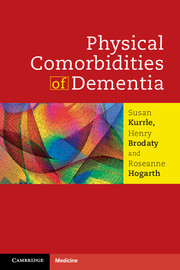Canonical definitions of dementia, like that enshrined in the Diagnostic and statistical manual of mental disorders (DSM-IV-TR, 2000), acknowledge that the dementia syndrome may be associated inter alia with such features as functional decline, falls, sleep disturbance, and epileptic seizures, as well as the cognitive decline. These physical comorbidities of dementia have perhaps attracted less research attention than the cognitive aspects, because they are not sine qua non in diagnosis. However, they are of disproportionate practical significance since they, rather than cognitive decline per se, may determine the need for nursing home placement and, for both patients are carers, may constitute the most distressing aspects of living with dementia.
The book takes the form of a systematic literature review of selected physical comorbidities of dementia, covering the period 1990-2011 and retrieving over 2500 references. The authors summarise their findings in chapters devoted to falls, delirium, epilepsy, weight loss and nutritional disorders, incontinence, sleep disturbance, visual dysfunction, oral disease, and frailty. Each chapter describes, where known, epidemiology, aetiology, assessment and management, and culminates in recommendations, two brief case studies, and key points.
Although much of the material may be familiar to clinicians who see patients with dementia, the review is welcome, and there is always something new to learn (I was entirely ignorant of the links between oral disease and dementia). The use of the generic descriptor ‘dementia’ rather than specific dementia subtypes probably reflects the historic (and current) lack of sophistication of studies in the literature. Where differences are known (e.g. sleep disorders in DLB, continence issues in FTD) these are covered. The recommendations in each chapter make this a practical resource for patient management, rather than simply an arid literature review, although in some spheres (e.g. epilepsy) the evidence base for intervention is limited or non-existent. It may be hoped that some of the areas of uncertainty will be addressed by the time of the next edition.
